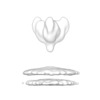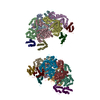+ データを開く
データを開く
- 基本情報
基本情報
| 登録情報 | データベース: EMDB / ID: EMD-11665 | ||||||||||||
|---|---|---|---|---|---|---|---|---|---|---|---|---|---|
| タイトル | Structure of GP in EBOV VP40-GP VLPs | ||||||||||||
 マップデータ マップデータ | Structure of GP in EBOV VP40-GP VLPs | ||||||||||||
 試料 試料 |
| ||||||||||||
| 生物種 |   | ||||||||||||
| 手法 | サブトモグラム平均法 / クライオ電子顕微鏡法 / 解像度: 12.8 Å | ||||||||||||
 データ登録者 データ登録者 | Wan W / Clarke M / Norris M / Kolesnikova L / Koehler A / Bornholdt ZA / Becker S / Saphire EO / Briggs JAG | ||||||||||||
| 資金援助 | European Union,  ドイツ, 3件 ドイツ, 3件
| ||||||||||||
 引用 引用 |  ジャーナル: Elife / 年: 2020 ジャーナル: Elife / 年: 2020タイトル: Ebola and Marburg virus matrix layers are locally ordered assemblies of VP40 dimers. 著者: William Wan / Mairi Clarke / Michael J Norris / Larissa Kolesnikova / Alexander Koehler / Zachary A Bornholdt / Stephan Becker / Erica Ollmann Saphire / John Ag Briggs /    要旨: Filoviruses such as Ebola and Marburg virus bud from the host membrane as enveloped virions. This process is achieved by the matrix protein VP40. When expressed alone, VP40 induces budding of ...Filoviruses such as Ebola and Marburg virus bud from the host membrane as enveloped virions. This process is achieved by the matrix protein VP40. When expressed alone, VP40 induces budding of filamentous virus-like particles, suggesting that localization to the plasma membrane, oligomerization into a matrix layer, and generation of membrane curvature are intrinsic properties of VP40. There has been no direct information on the structure of VP40 matrix layers within viruses or virus-like particles. We present structures of Ebola and Marburg VP40 matrix layers in intact virus-like particles, and within intact Marburg viruses. VP40 dimers assemble extended chains via C-terminal domain interactions. These chains stack to form 2D matrix lattices below the membrane surface. These lattices form a patchwork assembly across the membrane and suggesting that assembly may begin at multiple points. Our observations define the structure and arrangement of the matrix protein layer that mediates formation of filovirus particles. | ||||||||||||
| 履歴 |
|
- 構造の表示
構造の表示
| ムービー |
 ムービービューア ムービービューア |
|---|---|
| 構造ビューア | EMマップ:  SurfView SurfView Molmil Molmil Jmol/JSmol Jmol/JSmol |
| 添付画像 |
- ダウンロードとリンク
ダウンロードとリンク
-EMDBアーカイブ
| マップデータ |  emd_11665.map.gz emd_11665.map.gz | 23.8 MB |  EMDBマップデータ形式 EMDBマップデータ形式 | |
|---|---|---|---|---|
| ヘッダ (付随情報) |  emd-11665-v30.xml emd-11665-v30.xml emd-11665.xml emd-11665.xml | 11.3 KB 11.3 KB | 表示 表示 |  EMDBヘッダ EMDBヘッダ |
| 画像 |  emd_11665.png emd_11665.png | 18 KB | ||
| アーカイブディレクトリ |  http://ftp.pdbj.org/pub/emdb/structures/EMD-11665 http://ftp.pdbj.org/pub/emdb/structures/EMD-11665 ftp://ftp.pdbj.org/pub/emdb/structures/EMD-11665 ftp://ftp.pdbj.org/pub/emdb/structures/EMD-11665 | HTTPS FTP |
-検証レポート
| 文書・要旨 |  emd_11665_validation.pdf.gz emd_11665_validation.pdf.gz | 206.8 KB | 表示 |  EMDB検証レポート EMDB検証レポート |
|---|---|---|---|---|
| 文書・詳細版 |  emd_11665_full_validation.pdf.gz emd_11665_full_validation.pdf.gz | 205.9 KB | 表示 | |
| XML形式データ |  emd_11665_validation.xml.gz emd_11665_validation.xml.gz | 5.9 KB | 表示 | |
| アーカイブディレクトリ |  https://ftp.pdbj.org/pub/emdb/validation_reports/EMD-11665 https://ftp.pdbj.org/pub/emdb/validation_reports/EMD-11665 ftp://ftp.pdbj.org/pub/emdb/validation_reports/EMD-11665 ftp://ftp.pdbj.org/pub/emdb/validation_reports/EMD-11665 | HTTPS FTP |
-関連構造データ
- リンク
リンク
| EMDBのページ |  EMDB (EBI/PDBe) / EMDB (EBI/PDBe) /  EMDataResource EMDataResource |
|---|
- マップ
マップ
| ファイル |  ダウンロード / ファイル: emd_11665.map.gz / 形式: CCP4 / 大きさ: 27 MB / タイプ: IMAGE STORED AS FLOATING POINT NUMBER (4 BYTES) ダウンロード / ファイル: emd_11665.map.gz / 形式: CCP4 / 大きさ: 27 MB / タイプ: IMAGE STORED AS FLOATING POINT NUMBER (4 BYTES) | ||||||||||||||||||||||||||||||||||||||||||||||||||||||||||||||||||||
|---|---|---|---|---|---|---|---|---|---|---|---|---|---|---|---|---|---|---|---|---|---|---|---|---|---|---|---|---|---|---|---|---|---|---|---|---|---|---|---|---|---|---|---|---|---|---|---|---|---|---|---|---|---|---|---|---|---|---|---|---|---|---|---|---|---|---|---|---|---|
| 注釈 | Structure of GP in EBOV VP40-GP VLPs | ||||||||||||||||||||||||||||||||||||||||||||||||||||||||||||||||||||
| 投影像・断面図 | 画像のコントロール
画像は Spider により作成 | ||||||||||||||||||||||||||||||||||||||||||||||||||||||||||||||||||||
| ボクセルのサイズ | X=Y=Z: 1.78 Å | ||||||||||||||||||||||||||||||||||||||||||||||||||||||||||||||||||||
| 密度 |
| ||||||||||||||||||||||||||||||||||||||||||||||||||||||||||||||||||||
| 対称性 | 空間群: 1 | ||||||||||||||||||||||||||||||||||||||||||||||||||||||||||||||||||||
| 詳細 | EMDB XML:
CCP4マップ ヘッダ情報:
| ||||||||||||||||||||||||||||||||||||||||||||||||||||||||||||||||||||
-添付データ
- 試料の構成要素
試料の構成要素
-全体 : Ebola virus - Mayinga, Zaire, 1976
| 全体 | 名称:  |
|---|---|
| 要素 |
|
-超分子 #1: Ebola virus - Mayinga, Zaire, 1976
| 超分子 | 名称: Ebola virus - Mayinga, Zaire, 1976 / タイプ: virus / ID: 1 / 親要素: 0 / 含まれる分子: all / NCBI-ID: 128952 / 生物種: Ebola virus - Mayinga, Zaire, 1976 / ウイルスタイプ: VIRUS-LIKE PARTICLE / ウイルス・単離状態: SPECIES / ウイルス・エンベロープ: Yes / ウイルス・中空状態: Yes |
|---|---|
| Host system | 生物種:  Homo sapiens (ヒト) Homo sapiens (ヒト) |
-分子 #1: GP
| 分子 | 名称: GP / タイプ: protein_or_peptide / ID: 1 / 光学異性体: LEVO |
|---|---|
| 由来(天然) | 生物種:  |
| 組換発現 | 生物種:  Homo sapiens (ヒト) Homo sapiens (ヒト) |
| 配列 | 文字列: MGVTGILQLP RDRFKRTSFF LWVIILFQRT FSIPLGVIHN STLQVSDVDK LVCRDKLSST NQLRSVGLN LEGNGVATDV PSATKRWGFR SGVPPKVVNY EAGEWAENCY NLEIKKPDGS E CLPAAPDG IRGFPRCRYV HKVSGTGPCA GDFAFHKEGA FFLYDRLAST ...文字列: MGVTGILQLP RDRFKRTSFF LWVIILFQRT FSIPLGVIHN STLQVSDVDK LVCRDKLSST NQLRSVGLN LEGNGVATDV PSATKRWGFR SGVPPKVVNY EAGEWAENCY NLEIKKPDGS E CLPAAPDG IRGFPRCRYV HKVSGTGPCA GDFAFHKEGA FFLYDRLAST VIYRGTTFAE GV VAFLILP QAKKDFFSSH PLREPVNATE DPSSGYYSTT IRYQATGFGT NETEYLFEVD NLT YVQLES RFTPQFLLQL NETIYTSGKR SNTTGKLIWK VNPEIDTTIG EWAFWETKKN LTRK IRSEE LSFTVVSNGA KNISGQSPAR TSSDPGTNTT TEDHKIMASE NSSAMVQVHS QGREA AVSH LTTLATISTS PQSLTTKPGP DNSTHNTPVY KLDISEATQV EQHHRRTDND STASDT PSA TTAAGPPKAE NTNTSKSTDF LDPATTTSPQ NHSETAGNNN THHQDTGEES ASSGKLG LI TNTIAGVAGL ITGGRRTRRE AIVNAQPKCN PNLHYWTTQD EGAAIGLAWI PYFGPAAE G IYIEGLMHNQ DGLICGLRQL ANETTQALQL FLRATTELRT FSILNRKAID FLLQRWGGT CHILGPDCCI EPHDWTKNIT DKIDQIIHDF VDKTLPDQGD NDNWWTGWRQ WIPAGIGVTG VIIAVIALF CICKFVF |
-実験情報
-構造解析
| 手法 | クライオ電子顕微鏡法 |
|---|---|
 解析 解析 | サブトモグラム平均法 |
| 試料の集合状態 | filament |
- 試料調製
試料調製
| 緩衝液 | pH: 7.4 |
|---|---|
| 凍結 | 凍結剤: ETHANE |
- 電子顕微鏡法
電子顕微鏡法
| 顕微鏡 | FEI TITAN KRIOS |
|---|---|
| 撮影 | フィルム・検出器のモデル: GATAN K2 QUANTUM (4k x 4k) 平均電子線量: 2.4 e/Å2 |
| 電子線 | 加速電圧: 300 kV / 電子線源:  FIELD EMISSION GUN FIELD EMISSION GUN |
| 電子光学系 | 照射モード: FLOOD BEAM / 撮影モード: BRIGHT FIELD |
| 実験機器 |  モデル: Titan Krios / 画像提供: FEI Company |
- 画像解析
画像解析
| 最終 再構成 | 想定した対称性 - 点群: C3 (3回回転対称) / 解像度のタイプ: BY AUTHOR / 解像度: 12.8 Å / 解像度の算出法: FSC 0.143 CUT-OFF / ソフトウェア - 名称: AV3 / 使用したサブトモグラム数: 11188 | ||||||
|---|---|---|---|---|---|---|---|
| 抽出 | トモグラム数: 55 / 使用した粒子像数: 164205 | ||||||
| CTF補正 | ソフトウェア:
| ||||||
| 最終 角度割当 | タイプ: OTHER / ソフトウェア: (名称: TOM, AV3) / 詳細: Constrained Cross Correlation |
 ムービー
ムービー コントローラー
コントローラー












 Z (Sec.)
Z (Sec.) Y (Row.)
Y (Row.) X (Col.)
X (Col.)





















